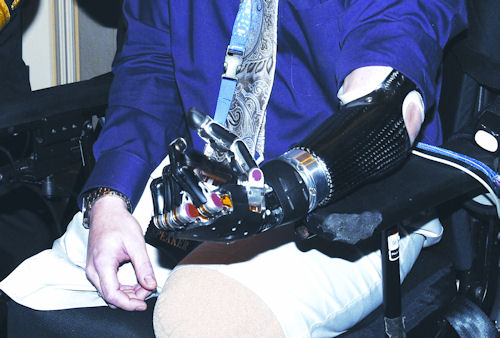Latest News
November 1, 2012
By Steve Robbins
It was back in 2009 at National Instruments Week in Austin, TX, when I witnessed Tim Dehne, vice president of Engineering for NI, pilot a wheelchair around the ballroom floor during the keynote speech using only his thoughts. I have to say I, like everyone else in the room, was blown away.
The control system for the wheelchair was developed by students at the University of Illinois at Urbana-Champaign. The device enables thought-based control of the chair. Wearing a sensor around a subject’s neck, the LabView system acquires impulse signals from the nerve that runs from the brain to the vocal cords. An algorithm processes the nerve signals and generates the appropriate control instructions to the wheelchair. Read more here.
Rapid Development
This spring, I was at the SME Rapid Expo in Atlanta. EOS, developer of laser sintering additive manufacturing systems, presented Dean Kamen to speak about a project funded by the Defense Advanced Research Projects Agency (DARPA). He talked about DARPA wanting to develop a neutrally controlled prosthetic arm for amputees.
Kamen’s company, DEKA Research and Development Corporation, has received an award from DARPA to design an advanced prosthetic arm and hand. DEKA solved the mechanical aspect of the design. I was impressed with how they used additive manufacturing to create a complex, high-quality base mount for all of the servo motors, electronic control systems and moving mechanical parts. The prosthetic arm is customized for each individual user, including a functional cosmetic covering.
During the talk, Kamen showed a video of the prosthetic being tested by a man who had lost both arms. He was able to feed himself and could pick up a glass of water. Again, everyone was blown away.
This September, one of the DARPA-funded prosthetic arms was controlled by a man with tetraplegia via his brain signals. Researchers from the University of Pittsburgh Medical Center and Caltech will be conducting pre-clinical trials using brain-controlled prosthetic arms by five volunteers who have spinal cord injuries.
 |
| Air Force Tech Sgt. Joe Deslauriers is learning the intricacies of his new arm. The DEKA arm has 10 degrees of movement. Photo courtesy of Rob McIlvaine |
Multi-disciplinary Design
The engineering work that has gone into these projects requires the coordination of a lot of engineering and other disciplines: medical, neural, control, embedded electronics, software, mechanical, materials, programming, signal processing, power management, and many more. They all have to integrate for the design to succeed. It is amazing that all of these scientists, programmers, engineers, companies, universities, and agencies ” all in different locations” could collaborate successfully to create this project.
DARPA has succeeded in moving the project close to completion and into the hands, literally, of the people who need the technology. It is going to be available to arm amputees in the very near future, if the Food and Drug Administration moves quickly. But where is this going to end up? Thought-controlled appliances? Cars? This innovation is mind boggling.
While the Six Million Dollar Man may not be in our immediate future (and would cost a lot more than $6 million), bionic technology may soon become part of our everyday lives. Think of the tools we use, and how they would change if they were controlled intuitively by using just our thoughts. Think of the innovation that is happening with mechanical devices that could operate in harsh environments, with great dexterity. Think of all the times in our lives that we have wished for another hand.
Steve Robbins is the CEO of Level 5 Communications and editorial director of DE. Send comments about this subject to [email protected].
Subscribe to our FREE magazine, FREE email newsletters or both!
Latest News






